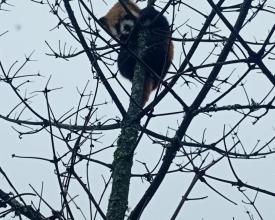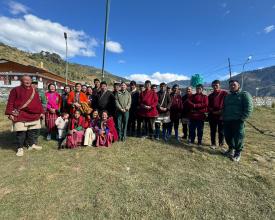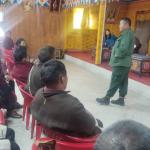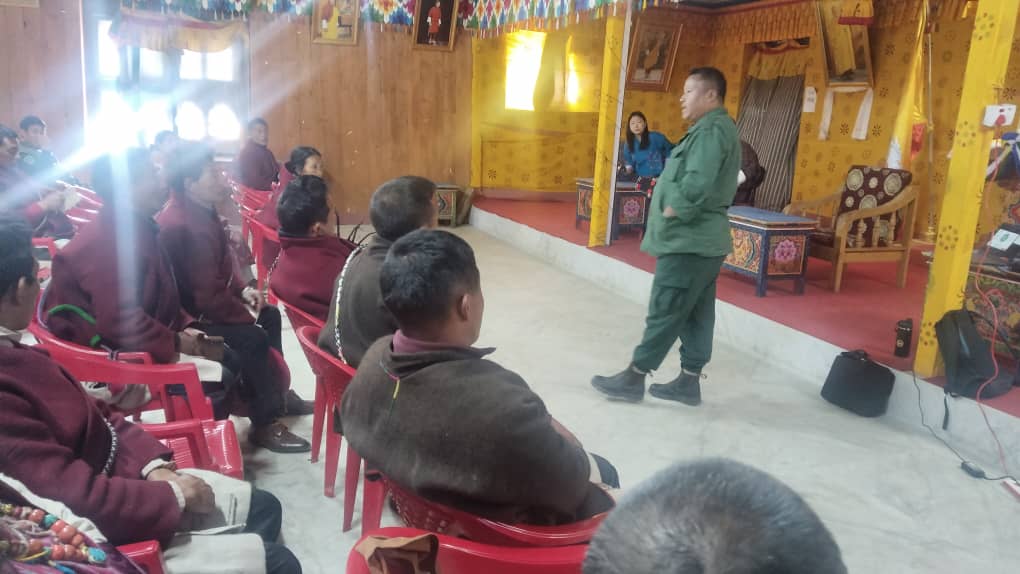From Field to Data – Farmers Supporting Wildlife Conservation in Sakteng Wildlife Sanctuary-Bhutan
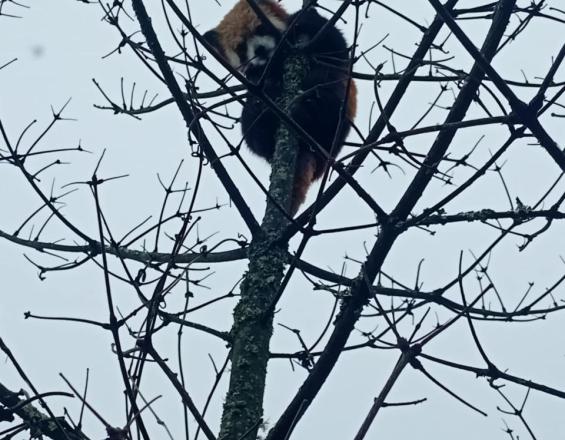
Wildlife plays a critical role in maintaining ecological balance, yet many species face increasing threats from poaching and the rising demand for their body parts for food, medicine, and trade. To address these challenges, Sakteng Wildlife Sanctuary (SWS) established a Wildlife Conservation Committee, a volunteer group made up largely of herders and farmers living close to the forest. Members are trained to document wildlife presence and detect signs of illegal activities using the NoteCam mobile application, which enables standardized data collection with GPS coordinates. This community-based monitoring approach strengthens early detection, supports informed conservation management, and empowers local people as active stewards of biodiversity.
Committee members share their observations with forestry officials and the SWS management team through a designated WhatsApp group. Officials verify and maintain the data, ensuring timely action, better monitoring, and stronger community involvement in wildlife conservation.
Context
Challenges addressed
The formation of the Wildlife Conservation Committee has been instrumental in addressing persistent challenges related to wildlife poaching and illegal hunting. In addition to enhancing law enforcement and community vigilance, the committee has helped fill critical data gaps on wildlife populations and behavior, which were previously difficult to monitor. Furthermore, it has extended conservation efforts to remote areas that foresters alone could not regularly cover, thereby strengthening overall wildlife protection and management across the landscape.
Location
Process
Summary of the process
The success of the community-led wildlife monitoring solution depends on three interconnected building blocks, each with a defined category and scale of implementation.
1. Volunteer Participation
Category: Alliance and partnership development and Co-management building
Scale: Local
Motivated local volunteers regularly observe wildlife and report threats, providing timely information that forestry officials alone cannot capture.
2. User-Friendly Mobile Technology (NoteCam)
Category: Collection of baseline data and knowledge & communication, out reach & awareness building
Scale: Local
Accessible tools like NoteCam allow volunteers to collect accurate, geo-tagged data regardless of education level, improving reporting quality and coverage across the sanctuary.
3. Targeted Training and Capacity-Building
Category: Education, training & other capacity development.
Scale: Local
Focused training ensures volunteers can use the app confidently and understand basic wildlife monitoring, resulting in consistent, high-quality data.
Together, these building blocks reinforce each other: engaged volunteers, simple technology, and proper training produce reliable data that strengthens community involvement and improves biodiversity conservation in Sakteng Wildlife Sanctuary
Building Blocks
Group Formation
The Wildlife Conservation Committee is formed entirely voluntarily, with members joining out of personal interest rather than financial gain. Voluntary participation ensures genuine motivation and yields more reliable data, whereas forced involvement could compromise the quality of the collected information. Most members are local residents who live close to the forest and are therefore well placed to observe wildlife and detect signs of poaching. However, the committee remains open to anyone interested, ensuring an inclusive and community-driven approach to monitoring.
Enabling factors
Enabling Factors
- Strong community interest and willingness to participate: The voluntary nature of the committee ensures members are genuinely motivated, resulting in more accurate and reliable wildlife observations.
- Proximity of members to forest areas: Most volunteers live near or within forest landscapes, giving them frequent opportunities to observe wildlife and detect signs of illegal activities.
- Inclusiveness and openness to all community members: Although many participants are herders or farmers, the committee is open to anyone who wishes to contribute, encouraging broader community involvement.
- Trust and collaboration between community and forestry officials: The established communication channels, such as the dedicated WhatsApp group, strengthen cooperation and encourage active reporting.
Lesson learned
Lessons Learned
- Voluntary participation leads to higher-quality data: Members who join out of personal motivation are more committed and provide more accurate and consistent observations than those recruited through pressure or obligation.
- Local communities are the most effective eyes and ears on the ground: People living near the forest have daily interactions with the landscape, making them well positioned to detect wildlife presence and poaching activities early.
- Continuous engagement strengthens reporting: Regular communication through the WhatsApp group keeps members active, improves coordination, and builds trust between volunteers and forestry officials.
- Training and simple digital tools enhance community capacity: Providing hands-on training and user-friendly applications like NoteCam enables community members to collect standardized data confidently and efficiently.
- Inclusiveness increases ownership and sustainability: Allowing anyone with interest to join fosters a sense of shared responsibility across the community, improving long-term commitment to wildlife conservation.
Technology used for data collection
The data collection approach is designed to be simple and accessible, accommodating the diverse educational backgrounds of Wildlife Conservation Committee members. The mobile application NoteCam is used for recording observations. This user-friendly app allows members to capture essential wildlife data—including GPS coordinates and altitude—simply by taking photos, making the monitoring process both efficient and reliable, even for those with limited technical experience.
Enabling factors
- User-friendly technology: The NoteCam mobile app is simple and intuitive, allowing members with diverse educational backgrounds to collect accurate wildlife data easily.
- Automated data capture: The app records essential information such as GPS coordinates and altitude automatically when photos are taken, reducing errors and simplifying reporting.
- Adapted to community needs: The simplicity and accessibility of the tool ensure that even volunteers with limited technical skills can participate effectively.
Supports timely and reliable monitoring: By making data collection straightforward, the app encourages consistent participation and ensures high-quality information for conservation management.
Lesson learned
- Simplicity drives participation: Tools that are easy to use encourage consistent engagement, even among volunteers with limited technical skills or formal education.
- Automated features improve data quality: Capturing GPS coordinates and altitude automatically reduces errors and ensures accurate, standardized data collection.
Tailoring technology to local contexts is key: Designing the app for practical, everyday use in forest communities increases adoption and long-term sustainability.
Training on use of the data collection technology
Forestry officials provided hands-on training to Wildlife Conservation Committee members on the use of the NoteCam data collection app. Training was delivered in the local language, ensuring all participants fully understood the procedures. In addition to technical guidance on data collection, members were educated on the importance of wildlife conservation and trained to recognize key signs of wildlife presence, equipping them with both the skills and knowledge needed for effective community-led monitoring.
Enabling factors
- Local language instruction: Delivering training in the local language ensured that all participants fully understood the procedures and concepts.
- Hands-on, practical approach: Direct, experiential training on the NoteCam app helped members gain confidence in data collection.
- Integration of conservation knowledge: Combining technical training with education on wildlife importance and signs of wildlife presence enhanced understanding and motivation.
- Support from forestry officials: Active involvement of officials provided guidance, credibility, and ongoing support to community volunteers.
- Accessible to diverse education levels: The training was designed to be inclusive, accommodating members with varied educational backgrounds.
Lesson learned
- Language and clarity matter: Training in the participants’ local language ensures comprehension and increases engagement.
- Practical, hands-on training is most effective: Members learn faster and retain skills better when they actively use the tools during training.
- Combining technical and conservation knowledge builds motivation: Understanding the purpose behind data collection encourages consistent participation.
- Ongoing support strengthens outcomes: Continuous guidance from forestry officials helps maintain data quality and volunteer confidence.
- Inclusivity ensures broader community engagement: Tailoring training to different education levels maximizes participation and sustainability.
Impacts
The community-led monitoring approach has significantly strengthened wildlife conservation in Sakteng Wildlife Sanctuary. By submitting over 200 verified records with GPS-tagged photos, the Wildlife Conservation Committee has improved the sanctuary’s understanding of species presence and distribution. Notable records, such as the Red Panda in Sakteng and two leopards in Merak, demonstrate the ability of local volunteers to detect rare and elusive species. This approach not only enhances early detection and timely response to potential threats but also empowers local communities as active custodians of biodiversity. Overall, integrating volunteer engagement, simple technology, and targeted training has created a sustainable and effective model for participatory wildlife monitoring and conservation.
Beneficiaries
Local communities’ familiarity with the data collection app allows them to report their location during emergencies, while also contributing valuable information for biodiversity monitoring. The local wildlife species are also benefited from this solution.
Global Biodiversity Framework (GBF)
Sustainable Development Goals
Story
The management was amazed when a Wildlife Conservation Committee member captured photographs and a video of two leopards in Merak while traveling by vehicle and shared them in the committee’s group. Prior to this, the management had only confirmed leopard presence through camera trap records.

